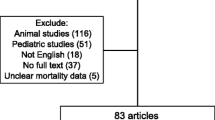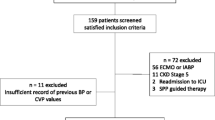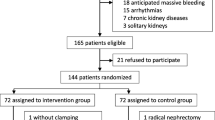Abstract
The impact of blood pressure targets and surgical approach (laparoscopic or open) on continuous urinary oxygenation (PuO2), a validated surrogate of renal medullary PO2, during general surgery, is unclear. We aimed to assess the effects of different blood pressure targets and surgical procedures on PuO2. We randomized patients receiving either laparoscopic or open surgery into two mean arterial pressure (MAP) target groups: usual MAP or a high MAP. We measured PuO2 in real-time and analyzed it according to the type of surgery and blood pressure target. The study was retrospectively registered on the 5th of July 2023 (ACTRN12623000726651). We included 43 participants who underwent either laparoscopic (n = 20) or open surgery (n = 23). We found that PuO2 significantly decreased during both laparoscopic and open surgery under a usual blood pressure target (− 51% and − 49%, respectively). However, there was a sharper fall with laparoscopic surgery resulting in a higher PuO2 with open surgery (mean difference: 11 ± 1 mmHg higher; p < 0.001). Targeting a higher MAP resulted in a higher PuO2 over time during laparoscopic surgery (mean difference: 7 ± 1 mmHg, p < 0.001). In contrast, targeting a usual MAP resulted in a higher PuO2 during open surgery (mean difference: 7 ± 1 mmHg, p < 0.001). Surgical approach and intraoperative blood pressure targets significantly impact urinary oxygenation. Further studies with larger sample sizes are needed to confirm these findings and understand their potential clinical implications.
Registration number: ACTRN12623000726651; Date of registration: 05/07/2023 (retrospectively registered).



Similar content being viewed by others
Data availability
The study protocol, data set and statistical code are available from the corresponding author on reasonable request.
References
Tsui C, Klein R, Garabrant M. Minimally invasive surgery: national trends in adoption and future directions for hospital strategy. Surg Endosc. 2013;27:2253–7. https://doi.org/10.1007/s00464-013-2973-9.
Schwenk W, Böhm B, Haase O, et al. Laparoscopic versus conventional colorectal resection: a prospective randomised study of postoperative ileus and early postoperative feeding. Langenbeck’s Arch Surg. 1998;383:49–55. https://doi.org/10.1007/s004230050091.
Lujan J, Valero G, Hernandez Q, et al. Randomized clinical trial comparing laparoscopic and open surgery in patients with rectal cancer. Br J Surg. 2009;96:982–9. https://doi.org/10.1002/bjs.6662.
Fretland ÅA, Dagenborg VJ, Bjørnelv GMW, et al. Laparoscopic versus open resection for colorectal liver metastases: the OSLO-COMET randomized controlled trial. Ann Surg. 2018;267:199–207. https://doi.org/10.1097/SLA.0000000000002353.
Perrin M, Fletcher A. Laparoscopic abdominal surgery. Continuing Educ Anaesthesia Crit Care Pain. 2004;4:107–10. https://doi.org/10.1093/bjaceaccp/mkh032.
O’Malley C, Cunningham AJ. Physiologic Changes during laparoscopy. Anesthesiol Clin North America. 2001;19:1–19. https://doi.org/10.1016/S0889-8537(05)70208-X.
Atkinson TM, Giraud GD, Togioka BM, et al. Cardiovascular and ventilatory consequences of laparoscopic surgery. Circulation. 2017;135:700–10. https://doi.org/10.1161/CIRCULATIONAHA.116.023262.
Kashtan J, Green JF, Parsons EQ, Holcroft JW. Hemodynamic effects of increased abdominal pressure. J Surg Res. 1981;30:249–55. https://doi.org/10.1016/0022-4804(81)90156-6.
Sharma KC, Brandstetter RD, Brensilver JM, Jung LD. Cardiopulmonary physiology and pathophysiology as a consequence of laparoscopic surgery. Chest. 1996;110:810–5. https://doi.org/10.1378/chest.110.3.810.
Kitano Y, Takata M, Sasaki N, et al. Influence of increased abdominal pressure on steady-state cardiac performance. J Appl Physiol. 1999;86:1651–6. https://doi.org/10.1152/jappl.1999.86.5.1651.
O’Leary E, Hubbard K, Tormey W, Cunningham AJ. Laparoscopic cholecystectomy: haemodynamic and neuroendocrine responses after pneumoperitoneum and changes in position. Br J Anaesth. 1996;76:640–4. https://doi.org/10.1093/bja/76.5.640.
McLaughlin JG, Scheeres DE, Dean RJ, Bonnell BW. The adverse hemodynamic effects of laparoscopic cholecystectomy. Surg Endosc. 1995;9:121–4. https://doi.org/10.1007/BF00191950.
Mikami O, Kawakita S, Fujise K, et al. Catecholamine release caused by carbon dioxide insufflation during laparoscopic surgery. J Urol. 1996;155:1368–71. https://doi.org/10.1016/S0022-5347(01)66268-2.
Damman K, van Deursen VM, Navis G, et al. Increased central venous pressure is associated with impaired renal function and mortality in a broad spectrum of patients with cardiovascular disease. J Am Coll Cardiol. 2009;53:582–8. https://doi.org/10.1016/j.jacc.2008.08.080.
Nohria A, Hasselblad V, Stebbins A, et al. Cardiorenal interactions: insights from the ESCAPE trial. J Am Coll Cardiol. 2008;51:1268–74. https://doi.org/10.1016/j.jacc.2007.08.072.
Damman K, Navis G, Smilde TDJ, et al. Decreased cardiac output, venous congestion and the association with renal impairment in patients with cardiac dysfunction. Eur J Heart Fail. 2007;9:872–8. https://doi.org/10.1016/j.ejheart.2007.05.010.
Kopitkó C, Gondos T, Fülöp T, Medve L. Reinterpreting renal hemodynamics: the importance of venous congestion and effective organ perfusion in acute kidney injury. Am J Med Sci. 2020;359:193–205. https://doi.org/10.1016/j.amjms.2020.01.012.
Schäfer M, Sägesser H, Reichen J, Krähenbühl L. Alterations in hemodynamics and hepatic and splanchnic circulation during laparoscopy in rats. Surg Endosc. 2001;15:1197–201. https://doi.org/10.1007/s004640080159.
Bishara B, Karram T, Khatib S, et al. Impact of pneumoperitoneum on renal perfusion and excretory function: beneficial effects of nitroglycerine. Surg Endosc. 2009;23:568–76. https://doi.org/10.1007/s00464-008-9881-4.
Demyttenaere SV, Taqi A, Polyhronopoulos GN, et al. Targeting individual hemodynamics to maintain renal perfusion during pneumoperitoneum in a porcine model. Surgery. 2007;142:350–6. https://doi.org/10.1016/j.surg.2007.02.018.
Srisawat N, Kongwibulwut M, Laoveeravat P, et al. The role of intraoperative parameters on predicting laparoscopic abdominal surgery associated acute kidney injury. BMC Nephrol. 2018;19:289. https://doi.org/10.1186/s12882-018-1081-4.
Khwaja A. KDIGO clinical practice guidelines for acute kidney injury. Nephron. 2012;120:c179–84. https://doi.org/10.1159/000339789.
Sunder S, Jayaraman R, Mahapatra HS, et al. Estimation of renal function in the intensive care unit: the covert concepts brought to light. J Intensive Care. 2014;2:31. https://doi.org/10.1186/2052-0492-2-31.
Osawa EA, Cutuli SL, Yanase F, et al. Effects of changes in inspired oxygen fraction on urinary oxygen tension measurements. ICMx. 2022;10:52. https://doi.org/10.1186/s40635-022-00479-y.
Lankadeva YR, Kosaka J, Evans RG, et al. Intrarenal and urinary oxygenation during norepinephrine resuscitation in ovine septic acute kidney injury. Kidney Int. 2016;90:100–8. https://doi.org/10.1016/j.kint.2016.02.017.
Osawa EA, Cutuli SL, Bitker L, et al. Effect of furosemide on urinary oxygenation in patients with septic shock. Blood Purif. 2019;48:336–45. https://doi.org/10.1159/000501512.
Zhu MZL, Martin A, Cochrane AD, et al. Urinary hypoxia: an intraoperative marker of risk of cardiac surgery-associated acute kidney injury. Nephrol Dial Transplant. 2018;33:2191–201. https://doi.org/10.1093/ndt/gfy047.
Levey AS, Stevens LA, Schmid CH, et al. A new equation to estimate glomerular filtration rate. Ann Intern Med. 2009;150:604–12.
Austin PC, Steyerberg EW. Bootstrap confidence intervals for loess-based calibration curves. Stat Med. 2014;33:2699–700. https://doi.org/10.1002/sim.6167.
Efron B, Narasimhan B. The automatic construction of bootstrap confidence intervals. J Comput Graph Stat. 2020;29:608–19. https://doi.org/10.1080/10618600.2020.1714633.
Naito A, Taguchi S, Suzuki M, et al. Transient acute kidney injury observed immediately after robot-assisted radical prostatectomy but not after open radical prostatectomy. Mol Clin Oncol. 2020. https://doi.org/10.3892/mco.2020.2087.
Long TE, Helgason D, Helgadottir S, et al. Acute kidney injury after abdominal surgery: incidence, risk factors, and outcome. Anesth Analg. 2016;122:1912–20. https://doi.org/10.1213/ANE.0000000000001323.
Valencia Morales DJ, Plack DL, Kendrick ML, et al. Urine output and acute kidney injury following laparoscopic pancreas operations. HPB. 2022;24:1967–74. https://doi.org/10.1016/j.hpb.2022.06.006.
Huang S, Li Z, Zou N, et al. Comparison of postoperative acute kidney injury between laparoscopic and laparotomy procedures in elderly patients undergoing colorectal surgery. Surg Laparosc Endosc Percutaneous Techniq. 2021;31:160. https://doi.org/10.1097/SLE.0000000000000858.
Paek JH, Kang SI, Ryu J, et al. Renal outcomes of laparoscopic versus open surgery in patients with rectal cancer: a propensity score analysis. Kidney Res Clin Pract. 2021;40:634–44. https://doi.org/10.23876/j.krcp.21.002.
Bravi CA, Larcher A, Capitanio U, et al. Perioperative outcomes of open, laparoscopic, and robotic partial nephrectomy: a prospective multicenter observational study (the RECORd 2 project). Eur Urol Focus. 2021;7:390–6. https://doi.org/10.1016/j.euf.2019.10.013.
Cheng H, Clymer JW, Po-Han Chen B, et al. Prolonged operative duration is associated with complications: a systematic review and meta-analysis. J Surg Res. 2018;229:134–44. https://doi.org/10.1016/j.jss.2018.03.022.
Hu RT, Lankadeva YR, Yanase F, et al. Continuous bladder urinary oxygen tension as a new tool to monitor medullary oxygenation in the critically ill. Crit Care. 2022;26:389. https://doi.org/10.1186/s13054-022-04230-7.
Silverton NA, Lofgren LR, Hall IE, et al. Noninvasive urine oxygen monitoring and the risk of acute kidney injury in cardiac surgery. Anesthesiology. 2021;135:406–18. https://doi.org/10.1097/ALN.0000000000003663.
Evans RG, Cochrane AD, Hood SG, et al. Dynamic responses of renal oxygenation at the onset of cardiopulmonary bypass in sheep and man. Perfusion. 2022;37:624–32. https://doi.org/10.1177/02676591211013640.
Vogiatjis J, Noe KM, Don A, et al. Association between changes in norepinephrine infusion rate and urinary oxygen tension after cardiac surgery. J Cardiothorac Vasc Anesth. 2023;37:237–45. https://doi.org/10.1053/j.jvca.2022.11.008.
Acknowledgements
We acknowledge research support from Austin Health Hospital and the work of all staff in supporting the health system and their patients.
Funding
The authors declare that no funds, grants, or other support were received during the preparation of this manuscript.
Author information
Authors and Affiliations
Contributions
Research idea and study design: DH, RB; data acquisition: DH, HS; data analysis/interpretation: all authors; supervision or mentorship: DH, CF, and RB Each author contributed important intellectual content during manuscript drafting or revision and accepted accountability for the overall work by ensuring that questions about the accuracy or integrity of any portion of the work are appropriately investigated and resolved.
Corresponding author
Ethics declarations
Conflict of interest
The authors declare having no conflict of interest to declare.
Implication statement
This study demonstrates that surgical approach and blood pressure targets significantly affect urinary oxygenation. A higher blood pressure target during laparoscopic surgery and usual blood pressure during open surgery yielded better oxygenation results, suggesting the need for individualized intraoperative management strategies.
Additional information
Publisher's Note
Springer Nature remains neutral with regard to jurisdictional claims in published maps and institutional affiliations.
Supplementary Information
Below is the link to the electronic supplementary material.
Rights and permissions
Springer Nature or its licensor (e.g. a society or other partner) holds exclusive rights to this article under a publishing agreement with the author(s) or other rightsholder(s); author self-archiving of the accepted manuscript version of this article is solely governed by the terms of such publishing agreement and applicable law.
About this article
Cite this article
Chaba, A., Hacking, D., Slifirski, H. et al. Renal medullary oxygenation during laparoscopic vs open surgery: the impact of blood pressure management—a pilot randomized controlled trial. J Clin Monit Comput 38, 337–345 (2024). https://doi.org/10.1007/s10877-023-01079-1
Received:
Accepted:
Published:
Issue Date:
DOI: https://doi.org/10.1007/s10877-023-01079-1




